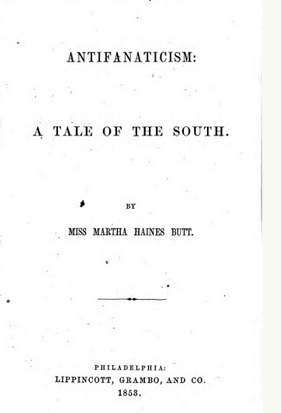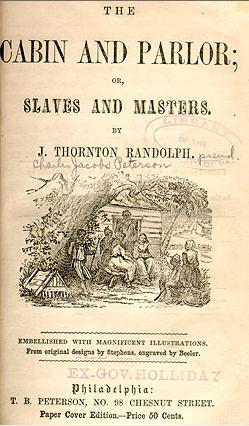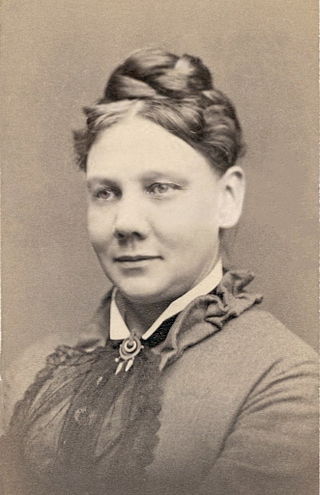Related Research Articles

Uncle Tom's Cabin; or, Life Among the Lowly is an anti-slavery novel by American author Harriet Beecher Stowe. Published in two volumes in 1852, the novel had a profound effect on attitudes toward African Americans and slavery in the U.S., and is said to have "helped lay the groundwork for the [American] Civil War".

Dred: A Tale of the Great Dismal Swamp is the second popular novel from American author Harriet Beecher Stowe. It was first published in two volumes by Phillips, Sampson and Company in 1856. Although it enjoyed better initial sales than her previous, and more famous, novel Uncle Tom's Cabin, it was ultimately less popular. Dred was of a more documentary nature whereas Uncle Tom's Cabin had much stronger characters.

Anti-Tom literature consists of the 19th century pro-slavery novels and other literary works written in response to Harriet Beecher Stowe's Uncle Tom's Cabin. Also called plantation literature, these writings were generally written by authors from the Southern United States. Books in the genre attempted to show that slavery was beneficial to African Americans and that the evils of slavery as depicted in Stowe's book were overblown and incorrect.

Aunt Phillis's Cabin; or, Southern Life as It Is by Mary Henderson Eastman is a plantation fiction novel, and is perhaps the most read anti-Tom novel in American literature. It was published by Lippincott, Grambo & Co. of Philadelphia in 1852 as a response to Harriet Beecher Stowe's Uncle Tom's Cabin, published earlier that year. The novel sold 20,000–30,000 copies, far fewer than Stowe's novel, but still a strong commercial success and bestseller. Based on her growing up in Warrenton, Virginia, of an elite planter family, Eastman portrays plantation owners and slaves as mutually respectful, kind, and happy beings.

The Planter's Northern Bride is an 1854 novel written by Caroline Lee Hentz, in response to the publication of Uncle Tom's Cabin by Harriet Beecher Stowe in 1852.

Tom show is a general term for any play or musical based on the 1852 novel Uncle Tom's Cabin by Harriet Beecher Stowe. The novel attempts to depict the harsh reality of slavery. Due to the weak copyright laws at the time, a number of unauthorized plays based on the novel were staged for decades, many of them mocking the novel's strong characters and social message, and leading to the pejorative term "Uncle Tom".
Uncle Robin, in His Cabin in Virginia, and Tom Without One in Boston is an 1853 novel written by J.W. Page and released by J. W. Randolph Publishers of Richmond, Virginia.

Antifanaticism: A Tale of the South is an 1853 plantation fiction novel by Martha Haines Butt.

Little Eva: The Flower of the South is an Anti-Tom children's book by American writer Philip J. Cozans. Although its publication date is unknown, scholars estimated the release was either in the 1850s or early 1860s. The book follows Little Eva, the daughter of a wealthy Alabama planter. She is characterized through her kindness toward slaves as she reads the Bible to them and teaches the alphabet to slave children. On her ninth birthday, Little Eva nearly drowns, but is rescued by a slave named Sam. Her parents free Sam who decides to remain with the family because he loves them.
White Acre vs. Black Acre is an 1856 plantation fiction novel written by William M. Burwell.

The Black Gauntlet: A Tale of Plantation Life in South Carolina is an anti-Tom novel written in 1860 by Mary Howard Schoolcraft, published under her married name of Mrs. Henry Rowe Schoolcraft.
The North and the South; or, Slavery and Its Contrasts is an 1852 plantation fiction novel by Caroline Rush, and among the first examples of the genre, alongside others such as Aunt Phillis's Cabin by Mary Henderson Eastman and Life at the South; or, "Uncle Tom's Cabin" As It Is by W.L.G. Smith, both of which were also released in 1852.
Frank Freeman's Barber Shop is an 1852 plantation fiction novel written by Baynard Rush Hall.

The Cabin and Parlor; or, Slaves and Masters is an 1852 novel by Charles Jacobs Peterson, writing under the pseudonym J. Thornton Randolph.
The Lofty and the Lowly, or Good in All and None All Good is a novel by Maria Jane McIntosh published by D. Appleton & Company in 1853. It was one of many anti-Tom novels published in response to Harriet Beecher Stowe's Uncle Tom's Cabin. The story is set is Georgia and tells of a plantation owner's efforts to avoid bankruptcy with the help of his loyal slave Daddy Cato. Their efforts are challenged by a northern usurer and devious northern capitalists. The book sold well across the United States upon release, making it one of the most successful anti-Tom novels in the middle 19th century.

Mr. Frank, the Underground Mail-Agent is an 1853 parody novel written by an unknown author credited as "Vidi".
The Ebony Idol is a plantation literature novel by G. M. Flanders, first published in 1860. It is one of several pro-slavery novels written in the Southern United States in response to the 1852 abolitionist novel Uncle Tom's Cabin by Harriet Beecher Stowe.

American Slavery as It Is: Testimony of a Thousand Witnesses is a book written by the American abolitionist Theodore Dwight Weld, his wife Angelina Grimké, and her sister Sarah Grimké, which was published in 1839.
Sons & Daughters of Thunder is a docudrama that portrays the true story of the Lane Seminary Debates on Slavery of 1834. Based upon a play from the 1970s by Earlene Hawley and Curtis Heeter, the film is the product of Kelly and Tammy Rundle of Fourth Wall Films of Moline, Illinois. The name Sons & Daughters of Thunder is based upon a Biblical phrase, Mark 3:17.

Mary Henderson Eastman was an American historian and novelist who is noted for her works about Native American life. She was also an advocate of slavery in the United States. In response to Harriet Beecher Stowe's anti-slavery Uncle Tom's Cabin, Eastman defended Southern slaveholding society by writing Aunt Phillis's Cabin: or, Southern Life As It Is (1852), which earned her considerable fame. She was the wife of the American illustrator and army officer Seth Eastman.
References
- ↑ Uncle Tom's Cabin Archived 2009-02-28 at the Wayback Machine , E-notes
- ↑ Stephen Railton, "Anti Uncle Tom Novels", Uncle Tom's Cabin & American Culture, University of Virginia, 1998–2009, accessed 23 February 2011
- ↑ "Colonization: Thirty-Sixth Anniversary of the American Colonization Society", New York Times, 19 January 1853
- ↑ W. L. G. Smith, Dedication, Life at the South, Uncle Tom's Cabin & American Culture, University of Virginia, 1998–2009, accessed 23 February 2011
- ↑ Weld, Theodore Dwight Archived 2009-02-25 at the Wayback Machine , The Columbia Encyclopedia, Sixth Edition, 2001–2005. Retrieved May 15, 2007
- ↑ Railton, "Other Anti Tom Texts", Uncle Tom's Cabin & American Culture, University of Virginia, 1998–2009, accessed 23 February 2011